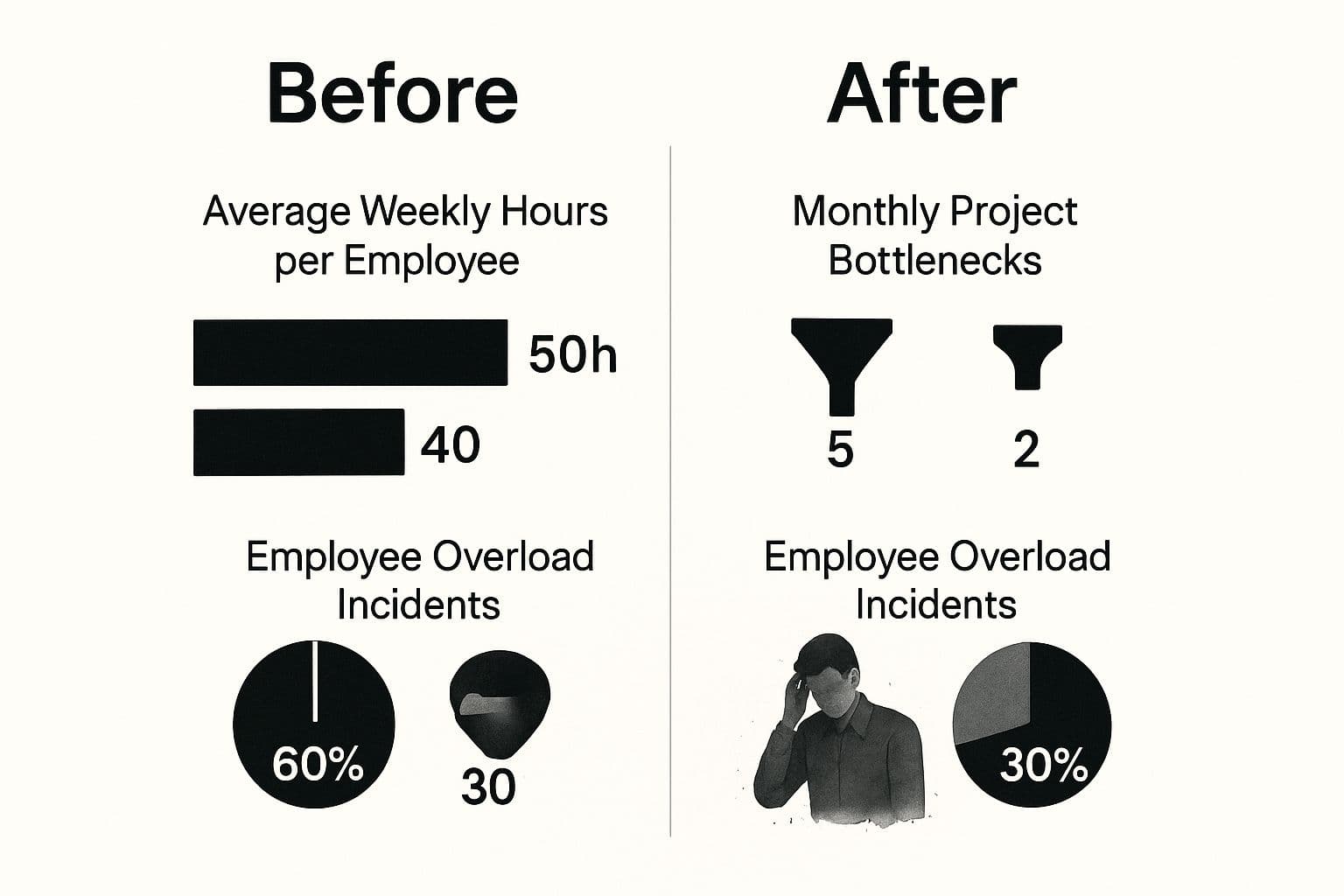Discover how to reduce employee burnout with actionable strategies for managers. Build a healthier team and boost productivity with these proven tips.
October 21, 2025 (1mo ago)
How to Reduce Employee Burnout for Managers
Discover how to reduce employee burnout with actionable strategies for managers. Build a healthier team and boost productivity with these proven tips.
← Back to blog
Let's be honest: employee burnout isn't just a buzzword. It's a silent killer of potential, productivity, and your company's bottom line. The secret to fighting it isn't complicated, but it does require a real commitment. It all comes down to three things: reshaping your work culture, managing workloads intelligently, and leading with genuine empathy. This isn't just about making people feel good—it's about building a resilient organization where your team can truly thrive.
The True Cost of Employee Burnout Today
What was once an occasional workplace problem has exploded into a full-blown crisis. Employee burnout is a state of chronic physical and emotional exhaustion, and it’s quietly dismantling team productivity, suffocating innovation, and pushing your best people out the door. Simply put, ignoring it is no longer an option.

The numbers are staggering. Recent research revealed that a shocking 82% of employees** are at risk of burning out. This isn't just a "soft" problem; it has hard financial consequences, costing companies an estimated $322 billion annually in lost productivity alone. You can dig into the full workplace burnout research to see just how deep this challenge runs.
This goes way beyond people just feeling tired. It's a systemic breakdown that impacts everything from project deadlines to client relationships. When your team is running on empty, they lose the creative spark and critical thinking skills needed to solve tough problems.
Understanding the Core Components of Burnout
To actually fix burnout, you first have to understand where it comes from. While every person's experience is different, most cases are rooted in a few common organizational pressures that leave people feeling completely overwhelmed and unappreciated. It's less of a personal failing and more of a natural response to an unsustainable work environment.
Here are the usual suspects:
- Unmanageable Workloads: A never-ending firehose of tasks with no clear priorities is the fastest way to drain anyone.
- Lack of Control: When people feel like they have no say in their work, schedule, or projects, they check out. Helplessness is a powerful de-motivator.
- Insufficient Recognition: Nothing kills motivation faster than hard work going completely unnoticed. It creates a "why even bother?" attitude.
- Poor Communication: Vague expectations and a lack of transparency from leadership are breeding grounds for anxiety and confusion.
Burnout is a bright, flashing warning sign that your company's processes and culture are out of sync with your team's capacity. Fixing it requires a real shift in how work is assigned, managed, and valued.
A Strategic Framework for Prevention
The good news? Burnout is absolutely preventable. But it requires a conscious, strategic effort focused on three key areas. Before we dive deep into each one, let's start with a quick overview of the core strategies for reducing employee burnout.
Three Pillars of Burnout Prevention
| Pillar | Core Principle | Key Actions |
|---|---|---|
| Culture Reshaping | Build an environment where well-being is a shared priority, not just an individual's problem. | Model healthy work-life boundaries, encourage open and honest communication, and celebrate outcomes over hours clocked. |
| Workload Management | Make sure tasks are distributed fairly and that deadlines are actually achievable. | Get a clear view of team capacity, use tools to balance assignments, and empower people to protect their time. |
| Authentic Leadership | Foster trust and psychological safety through supportive, transparent management. | Conduct regular well-being check-ins, provide constructive feedback, and actively listen to what your team is telling you. |
Tackling employee burnout isn't about finding a single quick fix. It's about building a sustainable system that puts your people first. By focusing on these three pillars, you can create a workplace that not only prevents burnout but also drives genuine engagement and long-term success.
Pinpointing the Real Causes of Burnout
When you see signs of burnout, it's tempting to point the finger at one thing: an overwhelming workload. But in my experience, while long hours are a huge part of the problem, they’re rarely the whole story. Burnout is a far more complex beast.
Often, the real culprits are hiding in plain sight. Things like fuzzy job expectations, a feeling of having no control over your own work, or a communication breakdown within the team can be far more draining than a packed schedule. When people don't know what success looks like or feel powerless to make decisions, their energy and motivation just plummet.

So, the first step is to stop assuming and start listening. If you want to get to the bottom of what's really going on, you have to create a space where your team feels safe enough to be honest.
Getting Honest Feedback Without Being Intrusive
You can't solve a problem you don't fully understand. But let's be realistic—asking "So, who's feeling burned out?" in a group meeting is a surefire way to get a roomful of blank stares. You need smarter, more structured ways to get genuine feedback.
And this isn't just a "nice-to-have" HR initiative. The financial hit from burnout is staggering. One study found that a company with 1,000 employees could lose around $5 million a year because of it. If you want to dig into the numbers, you can explore the findings on employee burnout costs for a deeper look.
Here are a few ways to collect the feedback you need:
- Craft Anonymous Surveys People Actually Fill Out: Keep them short and specific. Ditch generic questions and ask about real pain points. Think: "How clear are your current project priorities?" or "Do you feel you have the autonomy you need in your role?"
- Structure Supportive One-on-Ones: These meetings should be about well-being, not just status updates. Try asking open-ended questions like, "What's one thing we could change to make your work more manageable?" or "Where are you hitting the most friction right now?"
- Use Pulse Surveys for a Real-Time Vibe Check: Short, frequent surveys—even just one or two questions sent weekly—can help you spot morale dips before they become full-blown crises.
The goal is to shift from interrogation to conversation. When your team sees that their feedback actually leads to change, they’ll start to trust the process and give you even better insights.
Uncovering the Hidden Causes of Burnout
Once you start collecting feedback, you'll begin to see patterns emerge. While every team's dynamic is different, I've found that a few underlying issues pop up again and again. Keep an eye out for these common, but often missed, problems.
Role Ambiguity When someone isn't clear on their responsibilities or what "a job well done" actually looks like, they waste a tremendous amount of mental energy just trying to figure out what they're supposed to be doing. That constant uncertainty is exhausting.
Lack of Autonomy We all know micromanagement is a motivation killer. If your people feel like they have no say over their tasks, deadlines, or how they approach their work, they start to feel like cogs in a machine. This is a fast track to burnout.
Breakdown in Communication Poor communication from leadership creates a vacuum, and people almost always fill that void with stress and anxiety. Being left in the dark about company changes, project direction, or even simple performance expectations makes everyone feel disconnected and insecure.
Perceived Unfairness Nothing kills morale faster than the sense that things are unfair. Whether it's an unequal distribution of work, a manager who clearly plays favorites, or inconsistent rules, this dynamic breeds resentment and cynicism across the entire team.
Getting a handle on these root causes is the single most important step. Once you know what’s truly driving exhaustion and disengagement, you can stop putting out fires and start solving the core problems.
Cultivating a Burnout-Resistant Culture
A healthy culture is your single best defense against burnout. This isn’t about surface-level perks like free snacks or a meditation app subscription; it’s about fundamentally rewiring how your team operates, communicates, and genuinely values well-being. Building this kind of resilient culture means weaving psychological safety and balance into the very DNA of your company.
It all has to start at the top. When leaders are firing off emails at 10 PM or chiming in on Slack while supposedly on vacation, they're sending a clear, unspoken message: this is what's expected here. To break this cycle, leaders must actively and visibly model the behaviors they want to see in their teams.

This means truly disconnecting after hours and putting up an "out of office" message that you actually respect. It means taking real, uninterrupted vacations where work is genuinely left behind. When people see their managers protecting their own time, it gives them the unspoken permission they need to do the same.
Foster Psychological Safety Through Open Dialogue
One of the most powerful tools against burnout is an environment where people feel safe enough to speak up without fear of punishment or humiliation. This concept, known as psychological safety, is the absolute bedrock of a healthy team. When it’s missing, people hide problems, avoid asking for help, and internalize stress until they simply can't take it anymore.
A psychologically safe culture actually encourages vulnerability. It's a space where an employee can say, "I'm feeling completely swamped with my current projects," and be met with support, not judgment. But this kind of environment doesn't happen by accident; it requires intentional effort from managers.
You can start by:
- Admitting your own mistakes. When a leader openly says, "I dropped the ball on that," it shows the team that it's okay to be imperfect.
- Asking for input and actually listening. Frame questions to invite different perspectives, like, "What am I missing here?" or "What are the potential blind spots with this approach?"
- Responding with curiosity, not criticism. When someone raises a concern, your first response should be to thank them for their honesty before you even think about problem-solving.
This kind of open dialogue is a game-changer. For more practical advice on this, check out our in-depth article on how to improve communication skills in the workplace.
Building a burnout-resistant culture means celebrating outcomes, not hours. It's shifting the team's focus from "who worked the latest" to "who delivered the most impact."
Implement Practical, Culture-Shifting Policies
Beyond individual behaviors, you need structural changes that actively protect your team's time and energy. These can't just be policies collecting dust in a handbook; they have to be active, enforced practices that prove your commitment to well-being.
Think about introducing initiatives that give people back their most valuable resource: focused time.
Focus Fridays A simple yet incredibly effective tactic is implementing "Focus Fridays"—a day with no scheduled internal meetings. This carves out a dedicated block of time for deep work, letting employees catch up and head into the weekend feeling accomplished instead of frazzled from a week of back-to-back calls.
Celebrate Outcomes, Not Hours It's time to shift what your team celebrates. Instead of praising someone for staying online late to finish a report, celebrate the quality and impact of the report itself. Publicly acknowledge efficient work, clever problem-solving, and great collaboration. This redefines "hard work" as being smart and effective, not just being busy.
Encourage Genuine Social Connections In today's remote and hybrid setups, isolation can be a massive contributor to burnout. Professional relationships are one thing, but personal connections are what build a true sense of community and support.
You don't need forced fun or awkward virtual happy hours. Instead, create low-pressure opportunities for people to actually connect:
- Non-work chat channels: A dedicated Slack or Teams channel for sharing pet photos, vacation plans, or hobbies helps people see each other as more than just colleagues.
- "Coffee chats": Encourage team members to schedule short, informal 15-minute video calls with no agenda other than to catch up and connect as people.
- Shared interests groups: Help facilitate groups for book lovers, gamers, or fitness enthusiasts. These build powerful bonds outside the context of project work.
These small, intentional efforts really do compound over time. They transform a collection of individuals into a cohesive, supportive team that looks out for one another, creating a powerful buffer against the pressures that lead to burnout.
Managing Workloads Without Micromanaging People
An overwhelming, chaotic workload is the fastest path to burnout. It's that sinking feeling of drowning in tasks with no clear sense of priority, and it can exhaust even your most dedicated people. The answer isn't to track every minute of their day; it's about getting a clear, shared picture of the work and building a system that balances the load fairly.
Forget those overly complex, rigid project management systems. The real key is using simple, visual tools that give everyone an immediate, honest look at who is working on what. When the workload distribution is out in the open, it's impossible to ignore who's getting overloaded. This transparency allows you to step in before anyone hits a wall.
This approach flips workload management from a source of stress into your best tool for preventing it.
Gaining a Transparent View of Team Capacity
You can't manage what you can't see. The very first step in heading off overload is to create a shared, visual snapshot of your team's current capacity. A visual dashboard, whether it's in a dedicated tool like Fluidwave or even a well-organized shared document, can instantly show who is stretched thin and who might have some bandwidth to help.
This isn't about looking over shoulders; it's about creating shared awareness. When the entire team can see the flow of work, they naturally become partners in balancing the load.
The goal is to shift from constantly putting out fires to proactively spotting a potential bottleneck a week before it happens. This single change is fundamental to cutting down on burnout.
This infographic paints a clear picture of what happens when you move from a reactive, manual approach to a more transparent, tool-supported one.

The data doesn't lie. A clearer view of workloads directly translates to fewer hours worked, smoother project delivery, and a significant drop in those overload incidents that kill morale.
A Real-World Scenario in Action
Let's make this tangible. Imagine Sarah, a manager, is steering a critical product launch. Her lead designer, Mark, is on the hook for all the marketing visuals. Glancing at their team's visual task board, Sarah sees Mark's column is overflowing with cards, while another designer, Chloe, has a much lighter load this week.
Instead of waiting for Mark to raise a red flag—which, let's be honest, he might not do until he's already fried—Sarah can act right away.
- She spots the bottleneck: The visual board makes it painfully obvious Mark’s workload is unsustainable if they want to hit the deadline.
- She reallocates resources: Sarah has a quick, informal chat with Mark and Chloe. They agree that Chloe can take over the social media graphics, freeing Mark to focus on the more complex launch assets.
- She prevents burnout: In just a few minutes, Sarah has balanced the workload, kept the project on track, and saved her top designer from heading toward exhaustion.
This isn't about complicated algorithms; it's just about having the right information at the right time. For a deeper look at these methods, our guide on workload management strategies offers more practical techniques.
Empowering Your Team Through Smart Delegation
Getting workload management right also hinges on smart delegation. Giving your people ownership is crucial, but it has to be done thoughtfully. To truly empower your team without micromanaging, you need to master effective delegation strategies. This is about more than just offloading tasks from your plate; it's about trusting your team with real responsibility and giving them the autonomy to deliver.
When you delegate work, you're also distributing opportunities for growth. This helps people feel more invested and in control—two powerful antidotes to the feelings of helplessness that fuel burnout. The result is a more resilient, engaged, and ultimately more productive team.
To see just how much of a difference this makes, let's compare the old way of doing things with a smarter, tool-based approach.
Manual vs. Smart Workload Management
| Challenge | Manual Approach (The Problem) | Smart Tool Approach (The Solution) |
|---|---|---|
| No Visibility | Managers rely on status meetings and gut feelings to gauge workloads. Imbalances are discovered too late. | A centralized dashboard provides a real-time, visual overview of every team member's capacity. |
| Uneven Distribution | The same high-performers are consistently assigned the most work, leading to burnout and resentment. | Work can be assigned based on actual availability, ensuring a more equitable and transparent distribution. |
| Reactive Problem-Solving | Issues like bottlenecks or overload are only addressed after they've already caused delays and stress. | Proactive alerts and visual cues highlight potential overloads before they become critical problems. |
| Lack of Autonomy | Employees have little insight into team priorities or their colleagues' workloads, leading to a sense of isolation. | Team members can see the bigger picture, understand priorities, and even volunteer to help others. |
The contrast is stark. While manual methods create friction and risk, a smart, visual system builds clarity and trust, directly supporting your team's well-being.
Sustaining Well-Being with Ongoing Support
Beating employee burnout isn't a project you can check off a list. It’s an ongoing commitment. The strategies and cultural shifts we've talked about are powerful, but they fizzle out without consistent, long-term reinforcement. Real change happens when you build sustainable systems that transform good intentions into a healthy, resilient workplace where your team can thrive for years.
This starts by fundamentally changing how you check in with your team. It's time to move beyond the robotic "What's the status on project X?" and start asking questions that actually matter. Genuine conversations about well-being, workload, and potential roadblocks are where real support begins.
From Status Updates to Genuine Conversations
A manager's role here is everything. Regular one-on-ones need to be a safe space dedicated to the employee, not just a review of their to-do list. When you create an environment where someone can honestly say, "I'm feeling stretched thin this week," without fear of judgment, you've unlocked the secret to proactive burnout prevention.
Here are a few ways I’ve seen managers completely shift the focus of these conversations for the better:
- Ask about their energy levels. Instead of asking what they’ve accomplished, try, "What parts of your work energized you this week, and what parts felt draining?" This reveals so much more about their engagement than a simple progress report ever could.
- Discuss roadblocks, not just tasks. A question like, "What's getting in your way or slowing you down right now?" can uncover systemic issues—like clunky processes or a lack of resources—that are huge contributors to stress.
- Talk about the future. Discussing career goals and development opportunities shows you're invested in them as people, not just their short-term output. This fosters a sense of purpose that acts as a powerful buffer against burnout.
These conversations give you the qualitative data—the human story—behind the performance metrics. They're an absolutely crucial part of a larger ecosystem of support.
Offering Meaningful and Flexible Support
Support isn't a one-size-fits-all solution. What one employee finds helpful, another might not. Giving people a range of options and empowering them with flexibility provides a crucial sense of control over their work and life, which directly fights the feelings of helplessness that fuel burnout.
Think about the real impact of flexible work arrangements. For so many people, the ability to adjust their start and end times to handle family needs or simply work when they're most productive is a complete game-changer. One study found that organizations focusing on employee well-being saw a 91% positive workplace well-being score, compared to just 51% for companies that don't. Flexibility is a huge piece of that puzzle.
Sustaining employee well-being is vital, particularly in a remote setting where the lines between work and home can blur. Discover actionable work-life balance strategies for remote workers.
Meaningful support also means investing in your team's growth. Providing access to professional development—whether through courses, mentorship, or new responsibilities—shows that you value them as individuals. It reframes their role from a simple job to a career path, which is fantastic for igniting passion and engagement.
Building a Lasting Feedback Loop
Finally, for any of this to stick, you have to close the loop.
When employees share concerns about their workload or offer suggestions for improving a process, they need to see that their feedback leads to actual change. If their input disappears into a black hole, they'll simply stop offering it, and trust will completely erode.
This feedback loop is your proof that well-being is a shared, lasting priority. When an employee sees a process change based on their suggestion or feels their manager actively helping to rebalance their workload after a conversation, it reinforces that their voice matters. This cycle of listening, acting, and communicating builds a powerful foundation of trust. For more ideas on this, explore our guide on workplace stress reduction techniques.
Ultimately, preventing burnout is a continuous process of listening, adapting, and genuinely caring. It’s about building a system where people feel seen, supported, and empowered every single day.
Frequently Asked Questions About Burnout
Even with the best game plan, tricky situations and specific questions are bound to come up as you work to tackle burnout on your team. Let's dig into some of the most common questions managers ask and get you some clear, practical answers for navigating these challenges in the real world.
How Can I Tell the Difference Between Stress and Burnout?
This is a critical distinction, and one that trips up a lot of leaders. Think of it this way: stress is usually short-term and tied to a specific challenge, like a big project deadline. It can be intense, for sure, but there's a sense that if you can just get through this crunch, things will ease up. You still feel like you're in the driver's seat, even if the road is bumpy.
Burnout is a different beast entirely. It’s a state of prolonged, chronic exhaustion that seeps into everything. It typically shows up in three ways:
- Overwhelming exhaustion: A deep, bone-deep tiredness that sleep doesn't fix.
- Cynicism and detachment: A feeling of distance from the job and your colleagues.
- A sense of ineffectiveness: The feeling that nothing you do matters or makes a difference.
An employee dealing with stress might say, "I'm slammed this week, but I'll get through it." Someone on the path to burnout is more likely to say, "I honestly don't see the point of any of this anymore." It's a shift from "I have too much to do" to "I don't care about what I have to do."
What if My Company Culture Resists Change?
Trying to shift a company culture from the middle of the org chart can feel like you're trying to turn a battleship with a canoe paddle. It's tough, but it’s far from impossible. The key is to start small and focus on what you can control: your own team.
You don't need a formal, top-down mandate to start making a real difference. Begin by modeling the behavior you want to see. Log off at a reasonable hour—and make sure your team sees you do it. Take your full lunch break away from your desk. Be ruthless about protecting your team's time by declining meetings that could have been an email and setting crystal-clear priorities.
Once your team starts feeling the benefits—and their performance reflects it—you’ll have a powerful, real-world case study. You can then take that success story to senior leadership and show them that a healthier, more sustainable approach doesn't just feel better, it delivers better results.
Is Burnout Just a Problem for In-Office Teams?
Absolutely not. In my experience, remote and hybrid teams face their own unique set of burnout traps. The lines between work and home get incredibly blurry, leading to an "always-on" culture where people feel guilty for not responding to a 10 PM email.
We also see a lot of digital presenteeism, which is the pressure to be constantly visible and active on platforms like Slack or Teams. It's exhausting. On top of that, the isolation that can creep in with remote work is a huge contributor to feeling disconnected and drained. As a manager of a remote team, you have to be incredibly intentional about creating connection and championing firm work-life boundaries.
Burnout isn't about where you work; it's about how you work. The core drivers—unmanageable workloads, lack of autonomy, and poor communication—can fester in any environment if you let them.
Won’t More Flexibility Just Lead to Less Productivity?
This is probably the most common fear I hear from managers, but honestly, the data and real-world results just don't back it up. Giving people more autonomy over when and where they work doesn't mean they'll work less; it means they can finally work smarter.
In fact, a recent study found that when employees are allowed to work on a schedule that suits them, they are less likely to feel stressed. When people can align their tasks with their natural energy levels and manage personal appointments without stress, they show up more focused, engaged, and efficient.
Trusting your team with flexibility sends a powerful message: "I see you as a professional and I value your well-being." That respect is one of the most effective antidotes to burnout you have.
Ready to move from constantly fighting fires to proactively building a fireproof team? Fluidwave gives you the tools to manage workloads visually, delegate with clarity, and create the transparency everyone needs to thrive. Start managing workloads smarter, not harder, with Fluidwave.
Focus on What Matters.
Experience lightning-fast task management with AI-powered workflows. Our automation helps busy professionals save 4+ hours weekly.